History
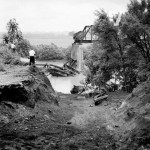 With all the rain we have been receiving, our area, along with many others have received multiple flash flood warnings, as well as flooding in many areas. When river water crosses a road, we are told not to drive through the flood, because it can take your car and cause your death. So many warnings are given to us in a flood situation. So much has been learned over the years about how to stay safe. So much has been learned about early warnings. So a lot of preparation is put in place, and yet, sometimes it’s just not enough. Such was the case on June 19, 1938.
With all the rain we have been receiving, our area, along with many others have received multiple flash flood warnings, as well as flooding in many areas. When river water crosses a road, we are told not to drive through the flood, because it can take your car and cause your death. So many warnings are given to us in a flood situation. So much has been learned over the years about how to stay safe. So much has been learned about early warnings. So a lot of preparation is put in place, and yet, sometimes it’s just not enough. Such was the case on June 19, 1938.
At that time, they didn’t have pickups that drove the rail system to check the tracks for problems. Instead a track walker was sent out to areas where there was a possible problem. Custer Creek is a small winding river that runs through 25 miles of the Great Plains on its way to the Yellowstone River. Minor streams like Custer Creek are prone to flash floods because their small capacity can quickly and easily be exceeded during heavy rains. A track walker was sent out to make sure everything was ok on the trestle at Custer Creek in Terry, Montana, and he reported that all was well there. Just a few hours later, a sudden downpour came through the area. The rising water in Custer Creek washed out the bridge and when the Olympian Special came through, it went crashing into the raging waters with no warning at all.
Two sleeper cars were immediately buried in the muddy waters, and the moonless night extremely hampered rescue efforts. In the end, 46 people lost their lives. The rear cars stayed above the water, but many passengers were seriously injured. To make matters worse, they could not be evacuated until the following morning. To hear of a train going into river in a flood is…at the very least, rare. I’ve heard of trains derailing…we all have, but this was different. On a moonless, pitch black night, my guess is that the engineer had no idea what 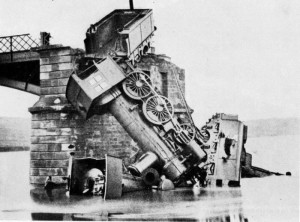 was about to happen. The shock must have been sickening to say the very least. Just knowing that people were going to die and there was nothing you could do about it, must have been the most horrible experience of an engineer’s life. Completely unimaginable.
was about to happen. The shock must have been sickening to say the very least. Just knowing that people were going to die and there was nothing you could do about it, must have been the most horrible experience of an engineer’s life. Completely unimaginable.
These days there are different safety measures in place, but that still doesn’t guarantee that such an event couldn’t happen again. I don’t know what the solution would be in these situations, but I’m sure that if there is one, technology will find a way to fix the problem. In those days, with the technology they had, they had done all they could, and yet, lives were still lost.
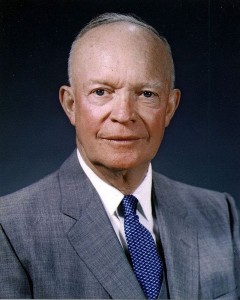 Not all of us can say that we knew a US President, before or during their presidency, but my uncle, Jim Wolfe could say that. Uncle Jim was in the army during World War II, and was on his way to England on a ship. Being the kind of guy who liked to see how things worked, Uncle Jim was laying on the back end of the ship watching the propeller go in and out of the water. Ike came up behind him and asked him if he was sick. Uncle Jim said, “No, I was just watching the prop.” Ike said, “Lord, man I would be so sick it would kill me and I’m on ships all the time.” He told Uncle Jim to come with him and they were going to go to Officers Mess and have coffee. Dad said “I can’t go there I will get in trouble.” Ike informed Uncle Jim that as long as he was with him, they wouldn’t say anything to him.
Not all of us can say that we knew a US President, before or during their presidency, but my uncle, Jim Wolfe could say that. Uncle Jim was in the army during World War II, and was on his way to England on a ship. Being the kind of guy who liked to see how things worked, Uncle Jim was laying on the back end of the ship watching the propeller go in and out of the water. Ike came up behind him and asked him if he was sick. Uncle Jim said, “No, I was just watching the prop.” Ike said, “Lord, man I would be so sick it would kill me and I’m on ships all the time.” He told Uncle Jim to come with him and they were going to go to Officers Mess and have coffee. Dad said “I can’t go there I will get in trouble.” Ike informed Uncle Jim that as long as he was with him, they wouldn’t say anything to him.
In the Officers Mess, Uncle Jim and Ike talked for a long time and then went their separate ways on the ship. When they got to England, Uncle Jim saw him a few times and then on D-Day, they found themselves on the same ship again. When they disembarked, they were under heavy fire, and my cousin Shirley Cameron tells me that Ike got a hold of her dad, my Uncle Jim and asked him how his shooting was. Uncle Jim said that it was good. Ike said, “See that guy in that tree way up there.” Uncle Jim said that he did, and Ike asked if he could hit him. Uncle Jim shot, hit, and killed the man. Ike said for Uncle Jim to stay with him. They were together for quite a while before they got separated. At that point, Uncle Jim was sent to another area.
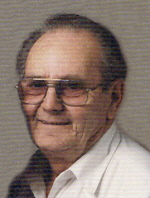
Uncle Jim ended up opening up some of the concentration camps. That was probably the worst part of his service. He said the men were like the walking dead. They were sick, weak, and skinny. All they could do was grab hold of him and thank him over and over for getting them out of that horrible place. Shirley tells me that he saw little wooden sheds that had bodies stacked from bottom to top, There were also pits that had bodies stacked in them ready for the heavy equipment to push the dirt over the top. She told me that experience gave him nightmares for years. He used to have pictures of all of that and the people that they helped out of the camps, but unfortunately they were lost in the fire that destroyed his home a number of years ago. After his time there, Uncle Jim was sent to France to help with the Liberation there. I’m sure he came home with many stories of the war, but as far as I know, that was the last time he ever saw the man who would later become our 34th US President, Dwight D Eisenhower…aka Ike.
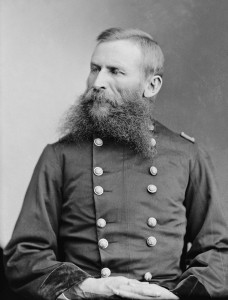 The states we now know as Montana and Wyoming, were originally supposed to belong to the Indians…a fact that many people don’t realize. Unfortunately, the White Man only stuck to a plan as long as the plan worked for the White Man. When gold was found in the Black Hills, there was no holding the White Man back. The plan was to try to buy the land from the Indians, but when that was not well received, they gave them an ultimatum…report to the reservations…or else. It was a matter of sell to us or we will take it…sound familar? The Indians simply did not take to the White Man’s plan very well. War broke out pretty quickly, and it was different than other wars, because the Indians did not play be the White Man’s rules of engagement. It was a very different type of war, and to win, the White Man would have to learn how to fight in a very different way. And it was a way they were not very good at.
The states we now know as Montana and Wyoming, were originally supposed to belong to the Indians…a fact that many people don’t realize. Unfortunately, the White Man only stuck to a plan as long as the plan worked for the White Man. When gold was found in the Black Hills, there was no holding the White Man back. The plan was to try to buy the land from the Indians, but when that was not well received, they gave them an ultimatum…report to the reservations…or else. It was a matter of sell to us or we will take it…sound familar? The Indians simply did not take to the White Man’s plan very well. War broke out pretty quickly, and it was different than other wars, because the Indians did not play be the White Man’s rules of engagement. It was a very different type of war, and to win, the White Man would have to learn how to fight in a very different way. And it was a way they were not very good at.
Most people remember the Battle of the Little Big Horn, in that so many men rode to their deaths. While Custer was in a place he shouldn’t have been, and a battle in which he was outnumbered, it is my opinion that he took a bad situation and did the best he could do with it. He went into battle knowing he would not survive it, and in that way it was brave. Even if the battle was not going to be won, it was brave. Still, that battle was not the only battle that showed bravery against daunting odds.
Just eight days earlier, Sioux and Cheyenne Indians won a major victory over General Crook’s forces at the Battle of the Rosebud. General Cook was in command of one of three columns of soldiers who were converging on the Big Horn Country of southern Montana that June. Sitting Bull, Crazy Horse, and several other chiefs had 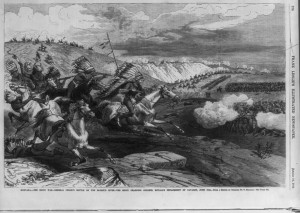 joined forces in the area. They were there in defiance on the US demands that the Indians confine themselves to the reservations. The army saw this protest as an opportunity to launch a massive three-proged attack, fully expecting to win a decisive vistory over the Indians.
joined forces in the area. They were there in defiance on the US demands that the Indians confine themselves to the reservations. The army saw this protest as an opportunity to launch a massive three-proged attack, fully expecting to win a decisive vistory over the Indians.
Crook and his men marched north from Fort Fetterman in Wyoming Terretory, intending to join the two others, the columns of General Gibbon and General Terry. General Terry’s force included the soon to be famous 7th Cavalry under the command of General George Custer. Given the distances between the troops and the lack of reliable communication, it was difficult to coordinate the three armys. Their plan was to converge on the valley of the Big Horn River and stage their assault. The biggest problem was that they had only a vague idea of how many men their enemy included, and they were way off.
Upon their arrival in the area, Crook’s scouts told him that there were signs of a major Sioux force in the area. Crook was convinced that the Sioux would run rather than fight, and he thought they were encamped near the Rosebud Creek. He wanted to attack before they had time to run. Unfortunately for him, they did not have the intel to know that they were severely outnumbered, not did he know that Crazy Horse was a brilliant war chief. The scouts tried to warn General Crook that Crazy Horse would never allow him to attack a stationary village, and he soon learned that they were right.
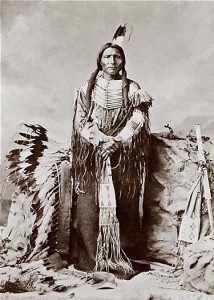 At around 8:00am on this day, June 17, 1876, Crook halted his force of 1,300 men in the bowl of a small valley along the Rosebud Creek to allow the rest of his men to catch up. The men unsaddled their horses, and within minutes a mass of Sioux Indians converged on them. They were hit by a force of 1,500 Sioux Indians and unbeknownst to Crook, Crazy Horse had an additional 2,500 warriors in reserve. Crazy Horse’s 4,000 warriors outnumbered Crook’s divided and unprepared army three to one. Had it not been for the wisdom and courage of Crook’s Indian allies, the battle would have ended just like the Battle of the Little Big Horn. There were numerous brave acts on both sides, including a Cheyenne girl who rescued her brother after his horse had been shot out from under him. In the end, 28 men were killed and 56 were seriously wounded. Crook withdrew his men. The warriors were emboldened and eight days later they joined up with their tribesmen in the Battle of the Little Big Horn, which of course, wiped out General George Custer and the 7th Cavalry.
At around 8:00am on this day, June 17, 1876, Crook halted his force of 1,300 men in the bowl of a small valley along the Rosebud Creek to allow the rest of his men to catch up. The men unsaddled their horses, and within minutes a mass of Sioux Indians converged on them. They were hit by a force of 1,500 Sioux Indians and unbeknownst to Crook, Crazy Horse had an additional 2,500 warriors in reserve. Crazy Horse’s 4,000 warriors outnumbered Crook’s divided and unprepared army three to one. Had it not been for the wisdom and courage of Crook’s Indian allies, the battle would have ended just like the Battle of the Little Big Horn. There were numerous brave acts on both sides, including a Cheyenne girl who rescued her brother after his horse had been shot out from under him. In the end, 28 men were killed and 56 were seriously wounded. Crook withdrew his men. The warriors were emboldened and eight days later they joined up with their tribesmen in the Battle of the Little Big Horn, which of course, wiped out General George Custer and the 7th Cavalry.
 On this day, June 16, 1961, the star of the Soviet Union’s Kirov Opera Ballet Company, Rudolf Nureyev defected while on a tour with the ballet company in France. He was 23 years old. It was a huge blow to the Soviet Union, both in the loss of Kirov Opera Ballet Company’s star, and that it severely damaged Soviet propaganda that touted the political and artistic freedom in Russia. But, Nureyev was not the first to defect, nor would he be the last. Communism had taken over Russia after the Russian Civil War, in which the Red Army successfully defended the Bolshevik government against various Russian and anti-Bolshevik armies. The Bolsheviks were Communist, and Russia would never be the same after their takeover.
On this day, June 16, 1961, the star of the Soviet Union’s Kirov Opera Ballet Company, Rudolf Nureyev defected while on a tour with the ballet company in France. He was 23 years old. It was a huge blow to the Soviet Union, both in the loss of Kirov Opera Ballet Company’s star, and that it severely damaged Soviet propaganda that touted the political and artistic freedom in Russia. But, Nureyev was not the first to defect, nor would he be the last. Communism had taken over Russia after the Russian Civil War, in which the Red Army successfully defended the Bolshevik government against various Russian and anti-Bolshevik armies. The Bolsheviks were Communist, and Russia would never be the same after their takeover.
My 4th great grandfather, Johann Georg Beyer was born in Germany in 1752, but the family immigrated to Russia in the mid 1700s, probably due to a poor economy in Gemany at the time. Later, when things heated up in Russia, the family decided to make the move to America. They worried about the impact Communism would have on their family, not to mention the fact that people were being pressed into service…even as young children. I believe that they got out pretty much in the nick of time to keep their family from being torn apart, however, one son was taken and to my knowledge, never heard from again.
There are many reasons why people would do everything they can to escape a Communist regime, and I’m sure that is also why Nureyev defected. I suppose that his life was different, since he had a talent that Russia wanted more than putting him in the army, but what if he could no longer dance? And what of his family should he have one? They might not be able to dance, and so might be forced to go into the army. And Russia has been saying that they had political and artistic freedom, but as we all know, that wasn’t true in reality. After defecting, Nureyev continued his career as a dancer. Over the next 30 years he danced with England’s Royal Ballet and the American Ballet Theatre. He was in great demand as both a dancer and choreographer, and even  made a few films, including an unsuccessful stint as the silent film star Rudolf Valentino. In 1983, he took over as ballet director of the Paris Opera. In 1989, he briefly returned to the Soviet Union to perform. He died in Paris in 1993.
made a few films, including an unsuccessful stint as the silent film star Rudolf Valentino. In 1983, he took over as ballet director of the Paris Opera. In 1989, he briefly returned to the Soviet Union to perform. He died in Paris in 1993.
While, Nureyev chose to return to Russia for a performance, possibly to show them that he was a free man, my grandfather’s family chose never to return to Russia, or to German as far as I know. It could have been that they distrusted the ability to get back out, but I think they just longed for a peaceful life, in a free nation, free from the tyranny of a corrupt government. That makes me wonder what they would think of things here in America now.
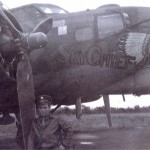 Many times I have written about my Dad’s time in the war, and what he went through, but I’m not sure I truly understood what he went through. Dad never talked about the war much, and maybe that led us to believe that what he went through wasn’t so bad for him. In reality, I don’t think I knew much about Dad’s service time at all. My nephew loaned me a movie called Fortress, and I was very interested in watching it. I don’t know what I expected it to be, but it was not. Everything on the B-17 happened so very fast.
Many times I have written about my Dad’s time in the war, and what he went through, but I’m not sure I truly understood what he went through. Dad never talked about the war much, and maybe that led us to believe that what he went through wasn’t so bad for him. In reality, I don’t think I knew much about Dad’s service time at all. My nephew loaned me a movie called Fortress, and I was very interested in watching it. I don’t know what I expected it to be, but it was not. Everything on the B-17 happened so very fast.
While the movie was quite graphic, and not one that some people would like to watch, it was based on a true story and it gave me a very different perspective about what it was like to fly in a B-17 Bomber. I knew that the life of a ball turret gunner in combat was a mere twenty minutes, and I knew that during the time Dad was on the B-17, there was at least one ball turret gunner who was killed. They tried to save him, but it was not to be. In an instant it was over.

The Flying Fortress, as the B-17 Bomber was called, was one of the safer parts of the war, but that meant nothing when you are flying to a bomb drop and the enemy doesn’t want you to make it. The movie brought home just how hard it was to really spot the enemy planes. They would say that the enemy was right there, and I found myself thinking, “Where?” Then suddenly there they were, and the men on the plane had been firing for several seconds already. It felt like trying to explain how to spot the enemy, and by the time you get the word “well” out, you have already been hit.
While any gunner position was dangerous, I was struck by how exposed the waist gunners were. In case you don’t know, the waist gunners are the guys that shoot out the side doors of the plane. The doors are open, leaving them with very little protection. They had to be on their toes, because the enemy was shooting for their gun, and if they weren’t paying attention, they were shot before they got a second chance to pay attention. That made things really hard, because they also felt a close commraderie with their partner, the other waist 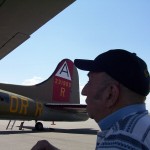 gunner, and if their partner got shot, it was hard to stay on task…but that was hard for any one of the men on the plane.
gunner, and if their partner got shot, it was hard to stay on task…but that was hard for any one of the men on the plane.
Watching the men they worked with every day, get shot and killed became a normal thing. Being normal and being able to cope, are two very different things. These men had to hold it together, while quietly falling apart inside. They knew their friend was dead, and yet they had to do their job. They couldn’t grieve. They couldn’t stop. They had to push that picture of their dead friend way back inside themselves, and do their job. Lives depended on it…including their own. I knew that my dad was on a B-17, but until I watched that movie, I really didn’t understand all of what that meant.
 I don’t know of any family relationship that exists in my family or in Bob’s family, but I have always had an interest in Benjamin Franklin anyway. I have done a lot of hiking in my life, and sometimes, like it or not, bad weather comes in before we were done with our hike. I think anyone who has hiked much knows that one of your worst enemies on a hike…other than mountain lions, bears, or snakes…is lightning. Personally, when I start to hear thunder, I figure it’s time to head for shelter, but when you are four or five miles from your car, in the middle of a bunch of trees, heading for shelter isn’t always an easy task.
I don’t know of any family relationship that exists in my family or in Bob’s family, but I have always had an interest in Benjamin Franklin anyway. I have done a lot of hiking in my life, and sometimes, like it or not, bad weather comes in before we were done with our hike. I think anyone who has hiked much knows that one of your worst enemies on a hike…other than mountain lions, bears, or snakes…is lightning. Personally, when I start to hear thunder, I figure it’s time to head for shelter, but when you are four or five miles from your car, in the middle of a bunch of trees, heading for shelter isn’t always an easy task.
Ben Franklin, on the other hand saw lightning as a challenge to be explored. I think he had to have known the dangers of such an adventure, because he was a scientist after all. That didn’t really matter to him much, or if it did, he did not show it. Ben Franklin became interested in electricity in the mid-1740s. Not much was known about the subject, but he would spend the next decade conducting experiments using electricity. It was Ben who coined terms still in use today. You now them…battery, conductor, and electrician. He also invented the lightning rod, which is now used to protect buildings and ships. All of these things came from his many experiments. Ben Franklin was an amazing man, publisher, and writer, but it is really not in his writings that I find myself intrigued, but rather his electrical experiments. On this day, June 10, 1752, Ben flew his now infamous kite during a thunderstorm to collect a charge in a Leyden jar, when the kite was struck by lightning. He wanted to demonstrate the electrical nature of lightning.
Benjamin Franklin was born January 17, 1706. People might think that Benjamin Franklin was a highly educated man, but in reality, his formal education ended at age ten. Then he went to work for his brother, James as a printer, but after a dispute in 1723, he left Boston and moved to Philadelphia and found work as a printer. He moved to London for a short time and worked there as a printer, and then returned to Philadelphia. He became a successful businessman whose publishing ventures included the Pennsylvania Gazette and Poor Richard’s Almanack, a collection of homespun proverbs advocating hard work and honesty in order to get 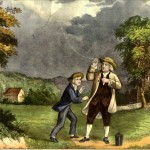 ahead. Eventually, Benjamin Franklin became an overachiever…or at least in the eyes of many people. I think he was just interested in a lot of things.
ahead. Eventually, Benjamin Franklin became an overachiever…or at least in the eyes of many people. I think he was just interested in a lot of things.
Of course, we all know about Benjamin Franklin’s career as a statesman, which spanned for decades, his years as a legislator, and his diplomatic years in England and France. He is the only politician to have signed all four documents fundamental to the creation of the US: the Declaration of Independence (1776), the Treaty of Alliance with France (1778), the Treaty of Paris (1783), which established peace with Great Britain, and the U.S. Constitution (1787). Yes, he was an all around amazing man, but I will always love the idea of his lightning experiments the best.
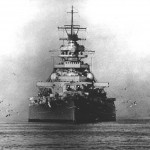 After I wrote the story about the sinking of the Bismarck, my nephew, Steve Spethman told me about a documentary he had about the man who located the Bismarck, and the search for it. Of course, I jumped at the chance to watch it, but when I was done watching it, I felt…different. It’s easy to be excited about a victory in a battle in wartime, or in a war that your dad fought in. It’s easy to set aside the thoughts of lives lost in historic battles, when you know that the battle had to be fought, and the victory would determine the course of the world stage. The problem with that thinking though, is that all too often…especially in countries governed by an evil dictator, such as Adolf Hitler, the people involved in the war, have no choice as to whether or not to fight. I know that a draft is sometimes necessary, but I would much rather have a military machine composed of volunteers than one from a draft. I think volunteers know what they are walking into. It is a cause they agree with, not one they were forced to accept.
After I wrote the story about the sinking of the Bismarck, my nephew, Steve Spethman told me about a documentary he had about the man who located the Bismarck, and the search for it. Of course, I jumped at the chance to watch it, but when I was done watching it, I felt…different. It’s easy to be excited about a victory in a battle in wartime, or in a war that your dad fought in. It’s easy to set aside the thoughts of lives lost in historic battles, when you know that the battle had to be fought, and the victory would determine the course of the world stage. The problem with that thinking though, is that all too often…especially in countries governed by an evil dictator, such as Adolf Hitler, the people involved in the war, have no choice as to whether or not to fight. I know that a draft is sometimes necessary, but I would much rather have a military machine composed of volunteers than one from a draft. I think volunteers know what they are walking into. It is a cause they agree with, not one they were forced to accept.
The movie about the Bismarck’s location, while mostly about the location of a sunken ship, was very different  from the documentaries I had seen about other ships, like the Titanic. While both ships were located by the same man, Robert Ballard, the feelings taken away from the Bismarck, both for Ballard and for the audience were quite different. The addition of commentary from some of the actual survivors of the Bismarck, as well as men on the ships who went in for the final sinking and the rescue of survivors, was very sobering. I was very moved by the German men who remembered the name of the man, Joe Brooks, who risked his own life to try to pull them from the water. They said, in fact, that his name was revered among German soldiers everywhere. This was a man who, in a war situation, chose to do good to his enemies…an almost unheard of act in wartime, but that act from the middle of a war, is still remembered 74 years later.
from the documentaries I had seen about other ships, like the Titanic. While both ships were located by the same man, Robert Ballard, the feelings taken away from the Bismarck, both for Ballard and for the audience were quite different. The addition of commentary from some of the actual survivors of the Bismarck, as well as men on the ships who went in for the final sinking and the rescue of survivors, was very sobering. I was very moved by the German men who remembered the name of the man, Joe Brooks, who risked his own life to try to pull them from the water. They said, in fact, that his name was revered among German soldiers everywhere. This was a man who, in a war situation, chose to do good to his enemies…an almost unheard of act in wartime, but that act from the middle of a war, is still remembered 74 years later.
So seldom, when talking about a war, do you hear about both sides of the war. While you may hear about  their goals and reasons for going to war, you don’t hear about the human factor of each side. I think that was the thing that made me feel so different…almost somber after the movie. One man said that in a sea battle, you usually never see the enemy. He saw men…just briefly as they were running across the deck of the Bismarck. That was it…until they were in the water beside his ship. Then they weren’t soldiers, but real people in dire straits, who were about to lose their lives. In the end, Robert Ballard stood alone at the back of the ship he was on when he found the Bismarck, and I could tell that he felt the same way as I did. The war and the battle had both been a necessary action on the part of the allies, because evil cannot be allowed to prevail, but that simply does not change the fact that these were real lives and real tragic situations.
their goals and reasons for going to war, you don’t hear about the human factor of each side. I think that was the thing that made me feel so different…almost somber after the movie. One man said that in a sea battle, you usually never see the enemy. He saw men…just briefly as they were running across the deck of the Bismarck. That was it…until they were in the water beside his ship. Then they weren’t soldiers, but real people in dire straits, who were about to lose their lives. In the end, Robert Ballard stood alone at the back of the ship he was on when he found the Bismarck, and I could tell that he felt the same way as I did. The war and the battle had both been a necessary action on the part of the allies, because evil cannot be allowed to prevail, but that simply does not change the fact that these were real lives and real tragic situations.
 The other day as I was driving to work, I noticed a bird in flight, and how it had to quickly change direction to avoid the car in front of me. Funny as it seems, a thought came to me that if this bird had lived in a different time in history, it would never have had to watch out for the car. in times past, there may have been a wagon or a horse, but if you go back far enough, people had to walk, and so even if they were running, they could not have gone as fast as the car in front of me that was in all reality going pretty slow, by today’s standards. Even the light poles we all take for granted wouldn’t have existed back then. Now lights and wires seem normal to the birds. They land on them as if they were a tree or a rock…or as if they were put there just for them. Often, we think about what life might have been like if we had lived in a different time in history, but rarely do we think of what the animals might have thought as the times changed.
The other day as I was driving to work, I noticed a bird in flight, and how it had to quickly change direction to avoid the car in front of me. Funny as it seems, a thought came to me that if this bird had lived in a different time in history, it would never have had to watch out for the car. in times past, there may have been a wagon or a horse, but if you go back far enough, people had to walk, and so even if they were running, they could not have gone as fast as the car in front of me that was in all reality going pretty slow, by today’s standards. Even the light poles we all take for granted wouldn’t have existed back then. Now lights and wires seem normal to the birds. They land on them as if they were a tree or a rock…or as if they were put there just for them. Often, we think about what life might have been like if we had lived in a different time in history, but rarely do we think of what the animals might have thought as the times changed.
Consider the horses at the time in history when the car was developed. They would often turn away, rear up, or run in the opposite direction when cars first appeared on the road. Then as time passed, the cars seemed no more strange that the person riding on the horses back or the wagon the horse was harnessed to. They were simply another object that the horse now lives in the same world with. And so it was with the bird. Granted the bird had to swiftly make a course change, but that did not mean the bird feared the car. The two of them were just traveling in a direction that put them in the same space at the same time, much like a car accident would.
Animals even get used to the people who share the same space. Take, for instance, the deer that many people…at least in Wyoming, have in our yards, and while they may not let us walk all the way up to them, they do not get up and run out of our yard in fear, but rather, watch us cautiously. Even the squirrels in my yard don’t necessarily run from us. As Bob and I walked out to our garage this morning to go the breakfast,  a squirrel playing near the garage stopped and looked at us. I talked to it, and still it stood there…not five feet from me. The fear of people had long since let this squirrel, possibly because of the fact that it has lived in this area all of its life, but more likely that my neighbors have long had a habit of feeding the squirrels. I suppose many people would not like the idea of feeding the squirrels, but the ones in our neighborhood don’t seem to damage the trees like the ones in other neighborhoods. Maybe because the neighbors feed them…who knows. Whatever the case may be, I can say that much has changed in the things the animals have seen as time has gone by. Like humans, they have adapted to it…getting used to the changes and seeing them as normal now. Maybe they even think, as I do, “Look how far we have come.”
a squirrel playing near the garage stopped and looked at us. I talked to it, and still it stood there…not five feet from me. The fear of people had long since let this squirrel, possibly because of the fact that it has lived in this area all of its life, but more likely that my neighbors have long had a habit of feeding the squirrels. I suppose many people would not like the idea of feeding the squirrels, but the ones in our neighborhood don’t seem to damage the trees like the ones in other neighborhoods. Maybe because the neighbors feed them…who knows. Whatever the case may be, I can say that much has changed in the things the animals have seen as time has gone by. Like humans, they have adapted to it…getting used to the changes and seeing them as normal now. Maybe they even think, as I do, “Look how far we have come.”
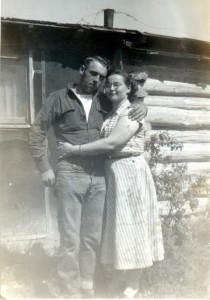 Sixty six years ago, when the bitterly cold winter of 1949 was finally over and spring had finally arrived, my mother-in-law, Joann Knox was a young girl of eighteen, and she was in love. She had known her future husband and the love of her life, Walter Schulenberg, all her life. Still, knowing him didn’t mean they were always in love, or even that they liked each other. Little kids can be friends with someone, and then when they get older, things change. Then, as was the case with my in-laws, things can change again. That annoying teenaged boy or girl suddenly takes on a new look to you. Suddenly, the time is right, and they both wonder why they didn’t see this person this way before. That’s how it was for my in-laws. Grandma Knox, Joann’s mom told me once that after they got older, Mom didn’t like Dad one bit. I would guess that was probably in his bratty adolescent years, when most boys are awkward around girls…especially if they like them at all.
Sixty six years ago, when the bitterly cold winter of 1949 was finally over and spring had finally arrived, my mother-in-law, Joann Knox was a young girl of eighteen, and she was in love. She had known her future husband and the love of her life, Walter Schulenberg, all her life. Still, knowing him didn’t mean they were always in love, or even that they liked each other. Little kids can be friends with someone, and then when they get older, things change. Then, as was the case with my in-laws, things can change again. That annoying teenaged boy or girl suddenly takes on a new look to you. Suddenly, the time is right, and they both wonder why they didn’t see this person this way before. That’s how it was for my in-laws. Grandma Knox, Joann’s mom told me once that after they got older, Mom didn’t like Dad one bit. I would guess that was probably in his bratty adolescent years, when most boys are awkward around girls…especially if they like them at all.
As the years went by, Walt and Joann moved in different circles, and didn’t really see each other very much, but then one day, he noticed her again. My mother-in-law wasn’t too sure how she felt about his new found interest in her, as she still thought of him as a bit of an annoying boy, but if you knew my father-in-law at all, you would know that he had a winning personality, and it was really hard not to like him. That is what my mother-in-law found too. Before long, they were an item. First meeting them after many years of marriage, and meeting them is a more reserved situation…for my mother-in-law at least, I never saw the love struck side of their early relationship. I don’t think their kids really did either. Their love letters, written during the times he was working one place and she another, were tender and sweet. It was such a surprise to see those letters, because they just never seemed to me to be the googly eyed kind of couple, and yet, here in their letters, they were.
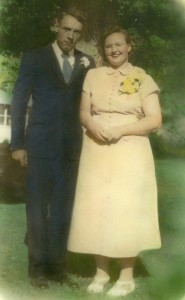
As time passed, their future plans began to grow, and when Joann graduated, they decided to be married. Like their granddaughter, Corrie Petersen, my daughter, they didn’t wait very long after graduation. The wedding took place on the 5th anniversary of D-Day, a fact that I seriously doubt that either of them gave a single thought to…at least not that year. Like many marriages of that time, it was a simple wedding…much like my own parents’ wedding just a few years later. My mother-in-law wore a simple peach colored dress and my father-in-law a suit. Nevertheless, it was for them the perfect day…the culmination of the many years of an on again, off again friendship, now turned to a forever kind of love. Today marks the 66th anniversary of that wedding day, and while my father-in-law has been gone now for two years, my mother-in-law is still alive, and since she does not realize that he is gone, we will still tell her happy anniversary…at the same time that we tell her that Dad is out in the garage working on a car, or at Walmart, or visiting the neighbors, because to tell her he is gone would be just too mean. Happy anniversary to my in-laws, Walt…in Heaven, and Joann, here on Earth. Have a wonderful day. We love you both very much.
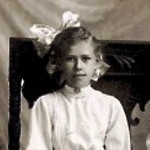 Whenever I read through my Great Aunt Bertha Schumacher Hallgren’s journal, I find something new. I may have read it before, but somehow, a new thought jumps out at me this time. Yesterday, as I was looking through it, I saw what a visionary she was. Many people kept clear family records, dating back for centuries, but the one thing that many of those records were void of was the stories that made up the lives of the people who were listed there. Aunt Bertha mentions that so much of how life was for our grandparents or great grandparents is being lost, because people only kept the birth, death, and marriage records, and never really told the future generation what their ancestors felt like. She was so right.
Whenever I read through my Great Aunt Bertha Schumacher Hallgren’s journal, I find something new. I may have read it before, but somehow, a new thought jumps out at me this time. Yesterday, as I was looking through it, I saw what a visionary she was. Many people kept clear family records, dating back for centuries, but the one thing that many of those records were void of was the stories that made up the lives of the people who were listed there. Aunt Bertha mentions that so much of how life was for our grandparents or great grandparents is being lost, because people only kept the birth, death, and marriage records, and never really told the future generation what their ancestors felt like. She was so right.
I often look for something more in the different sources that I use to build my family history, and even when there is a story, often it is simply and statement saying that the person died on a given day, and was buried in a certain place. While that can be good information, it doesn’t really tell anything about the person. I want to hear about their life. I want to know about some exciting things that they accomplished. Often, people don’t even post their obituary in it’s entirety. That is another sad thing, because it makes it hard to know for sure is this particular person is the ancestor you are looking for. The obituary would tell about their parents, siblings, children, and grandchildren. That information alone can fill in a history that has been missing a lot of really interesting and important information.
Birth and death certificates are another area that seems to be sorely missed in the actual media area of a persons information of Ancestry. Wehn you want to know about an epidemic that has hit, you have a real struggle on your hands. Much research is needed to find out what cause the deaths of people in the not so distant past, and it can be really frustrating. Marriage certificates are hard to find too sometimes. It really makes me sad that all of this documentation is missing from history, and all the stories about life are missing 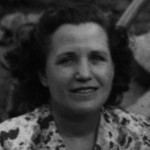 too. It really is up to us to make sure they get in there, just like my Aunt Bertha points out. Just knowing the dates does little to show who they really were.
too. It really is up to us to make sure they get in there, just like my Aunt Bertha points out. Just knowing the dates does little to show who they really were.
I’ve been guilty of this myself. You get in a hurry, and forget to put in the personal information. I suppose it does help that I have written stories about these things, but I have not necessarily connected them with Ancestry, so that other people would be able to read some of it. I can see that I’m going to have to start doing a better job of putting in the stories that go with some of the people I am researching. People’s lives have so many interesting stories in them…so many twists and turns in their journeys, and I want to be like my Aunt Bertha, and pass that information along for posterity.

